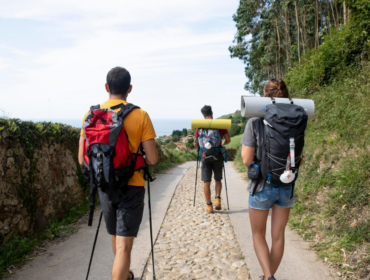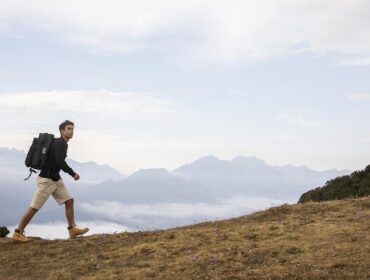As an essential item of clothing, there are a lot of factors to consider when buying a hiking jacket. When spending time in the wilderness, you want to make sure you have something that will be durable, versatile, and keeps you comfortable and warm.
Choosing a jacket for hiking can be overwhelming, especially when there are so many things to consider. A few questions you might want to consider when selecting the perfect hiking jacket are:
- What is the climate like where you will spend most of your time hiking?
- What is the perfect jacket for this climate? Lightweight, packable, comfortable, waterproof?
- Do you need to save space? Will you likely be using this jacket for day hikes or for backpacking?
- Is pricing and environmental responsibility important to you?
Once you have narrowed these questions down, we can begin to look at types of jackets suited for hiking.
Most common jacket types
- Hardshell / softshell
- Fleece
- Insulated (i.e. “puffy” jacket)
Now we need to consider the materials: natural versus synthetic. When selecting your perfect jacket, it is good to understand the materials so you can choose which will excel.

Hardshell
A hardshell jacket is typically a waterproof jacket with a hood, often designed to be lightweight, breathable and protect from the elements. When hiking in a warmer climate, I still bring my hardshell jacket to protect myself from the harsh rays of the sun while still wearing a breathable fabric. In some instances, a shell will be insulated. However, the term “hardshell” means an outer layer that is durable with a primary purpose of protection from wind and/or water.

Softshell
Softshell jackets are lightweight, breathable, and typically water-resistant and windproof. Most commonly made from woven synthetic materials that are pliable and lightweight, softshell jackets are one of the more versatile, year-round jackets.
They can be worn as part of a layering system. You can insulate with other articles of clothing for activities such as snowboarding, skiing, and winter hiking.

Fleece
Warmth without bulk. A fleece jacket is commonly used as an insulating material for cold weather or cooler climates. A fleece can either be made from natural wool, or using synthetic materials with similar functions. Best for use in dry conditions, a fleece will keep you warm and can act as an outer layer in cross-seasons like fall or spring. Although not waterproof, a fleece won’t get waterlogged due to the moisture-wicking materials. Still, if you need that layer of rain or wind protection, it is very easy to layer a fleece under a shell.

Insulated jacket
An insulated jacket is most commonly referred to as a “puffy” or a “puffer jacket.” Their primary purpose is to reduce the amount of heat your core losses to the atmosphere in cold weather conditions. An insulated jacket is versatile for hiking as they are commonly lightweight, packable and will keep you warm. An insulated jacket is an excellent layering jacket, however not typically waterproof, so it will be important to carry a shell for use when it comes to rain or snow.
Bonus: Some hikers like to use their puffy rolled up as a “pillow” when backpacking to reduce weight.
Environmental factors and pricing
Pricing of these materials can be a key factor when determining what is the perfect hiking jacket for you. Man-made synthetic materials are often cheaper to produce. Nowadays, it is easier to recycle polyester fibers, which are not necessarily worse for the environment simply on the basis it is synthetic. Personally, I opt to invest in any recycled material where I can.
An insulated down jacket is sourced from waterfowl, harder to manufacture than fleece, and tends to be on the expensive side. Duck down can be more cost effective however, it is important to always seek information on how it is sourced. I would recommend avoiding purchasing anything that doesn’t have a certification and traceable down standard. If you are looking to reduce impacts on the environment and animals, source clothing that is either recycled, synthetic or cruelty-free.
Other things to consider:
It is important to note that there are many different jackets for all types of outdoor activities. Although, when it comes to selecting the perfect jacket for hiking, some of the key factors to consider outside of the fabric and usage are:
- Ventilation – Are you hiking in a wet or humid environment? Do you require mesh, open arm pits?
- Pockets – It’s important to know how you will stow away a phone or camera if you’re wearing a backpack. Are these pockets open or zippable?
- Hood – This acts as sun protection, as well as protection from the harsh cold and wind.
- Zippers – Are they strong enough for frequent use and changing weather conditions?
- Durability – Does the jacket have reinforced shoulders and/or cuffs for the wrist and a cinched in waistband for protection against the changing elements?
Having a jacket that suits your adjustability needs and comfort needs is crucial. If there is one thing I have learned from my years of hiking various terrains and climates around the world, it is that your comfort is key.
You might end up investing in one of all of these jackets, depending on the location in which most of your hiking adventures will take place. Personally, I have sourced and collected four perfect hiking jackets over the years. At times I have worn only one, or all four together. It is a personal decision that will come down to intended use, cost, and your hiking climate. Knowing what you seek in a hiking jacket will ultimately help you when it comes to selecting one that is perfect for you.
Lastly, please always remember to familiarize yourself with the 7 Leave No Trace Principles when it comes to the safety and protecting our wild places. It is important to always be respectful to the land and pay respects to the traditional custodians of where you live, walk, adventure.
Article written by Melissa Findley
Featured Image from Nathan Dumlao/Unsplash




